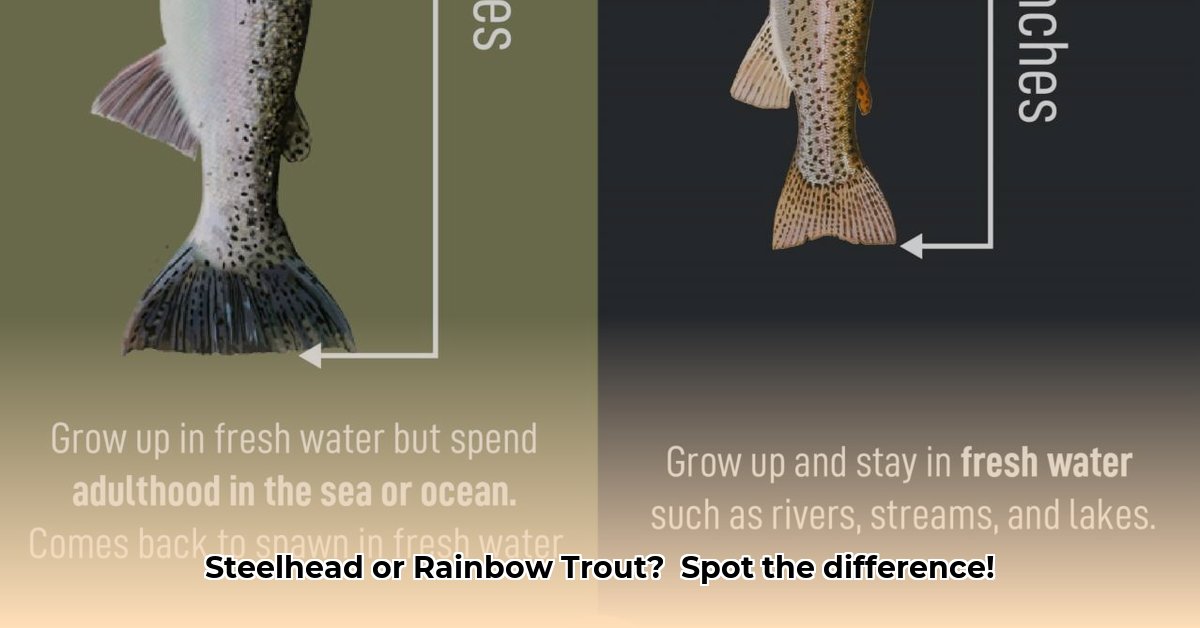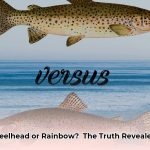Did you know the mighty steelhead and the humble rainbow trout are actually the same fish? It’s a bit of a biological magic trick, a tale of two lifestyles within a single species, Oncorhynchus mykiss. One stays home, the other travels the world. One boasts vibrant colors, the other shimmers like polished steel. So, what’s the real story behind these seemingly different fish?
Two Paths, One Fish: The Anadromy Advantage
The key difference boils down to one word: anadromy. Steelhead are anadromous, meaning they’re born in freshwater, migrate to the ocean to mature, and then, remarkably, return to their birthplace to spawn. Rainbow trout, however, typically remain in their freshwater homes throughout their lives. This “travel bug,” likely triggered by a combination of genetic predisposition and environmental cues like water temperature and food availability, is the catalyst for the striking differences between these two forms of O. mykiss.
A Visual Guide: Spotting the Difference
While telling a steelhead from a rainbow trout can sometimes be tricky, here’s a quick guide to the most common distinguishing features:
| Feature | Steelhead | Rainbow Trout |
|---|---|---|
| Typical Size | Larger (26+ inches, can exceed 45 inches) | Smaller (typically under 26 inches) |
| Typical Color | Silvery, almost chrome-like after ocean migration | Vibrant, rainbow hues, distinct lateral band |
| Body Shape | Torpedo-like, streamlined | More compact, robust |
| Jaw (Males) | Often develops a hooked jaw (kype) during spawning | Usually no kype |
| Habitat | Ocean and freshwater (migratory) | Freshwater only |
Remember, these are general tendencies, and individual fish may vary. A young steelhead fresh from the ocean might retain some rainbow coloration, while a large, well-fed rainbow trout in a lake environment can sometimes resemble a steelhead. This adaptability is part of what makes O. mykiss so fascinating.
(Image: Illustration comparing the typical appearance of a Steelhead and a Rainbow Trout)
From Stream to Sea: A Tale of Two Diets
The steelhead’s ocean journey dramatically impacts its size, shape, and flavor. The abundant food supply in the ocean, including shrimp, krill, and smaller fish, fuels rapid growth, resulting in a larger, more muscular fish compared to its freshwater counterpart. This richer diet also imparts a robust, often salmon-like flavor to the steelhead’s flesh. Rainbow trout, with their diet of insects, larvae, and other freshwater organisms, tend to have a milder, sometimes slightly nutty flavor.
The Great Lakes Exception: A Freshwater Twist
Adding to the complexity, rainbow trout introduced to the Great Lakes have adapted to this vast freshwater environment, exhibiting some migratory behavior and growing larger, similar to steelhead. While they might resemble steelhead in some ways, they haven’t undergone the same ocean-driven transformation. This raises interesting questions about the adaptability of O. mykiss and the blurry lines between these two life histories.
Spawning Rituals: The Kype and the Journey Home
When it’s time to reproduce, both steelhead and rainbow trout undergo transformations. The most noticeable change occurs in males, who often develop a hooked jaw called a kype, used in courtship displays and competition for mates. However, it’s the steelhead’s epic journey back to its natal stream that truly sets it apart. This incredible feat of navigation highlights the instinctual drive and remarkable resilience of these fish.
Conservation Considerations: Protecting a Shared Future
Whether you call them steelhead or rainbow trout, understanding the complex life history of O. mykiss is crucial for conservation efforts. Factors like habitat loss, pollution, and climate change can impact both forms of the species. Ongoing research, often aided by tools like Python for data analysis and visualization, helps scientists track migration patterns, assess population health, and develop effective conservation strategies.
A Taste of the Difference: From River to Table
The distinct life histories of steelhead and rainbow trout also translate to culinary differences. Steelhead, with its richer, fattier flesh, lends itself well to grilling, baking, and pan-searing. Rainbow trout, with its milder flavor and delicate texture, shines in lighter preparations like pan-frying or poaching. Ultimately, the best way to appreciate the difference is to try them both!
NOAA Fisheries: Steelhead Trout
Scientific American: The Amazing Journey of Salmon
By understanding the fascinating interplay of genetics and environment that shapes the lives of steelhead and rainbow trout, we can better appreciate the remarkable adaptability and resilience of this iconic species. And who knows, ongoing research may yet reveal more secrets about the intriguing double life of Oncorhynchus mykiss.
- Water Mill Electricity Generator Provides Free Home Power - December 16, 2025
- Water Wheel Electric Generator Provides Free Home Electricity - December 15, 2025
- Choosing the Right Portable Hydro Turbine for Your Needs - December 14, 2025
















